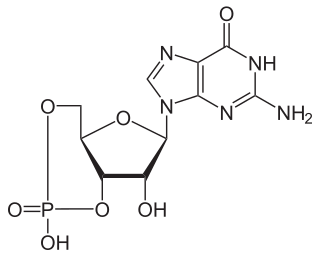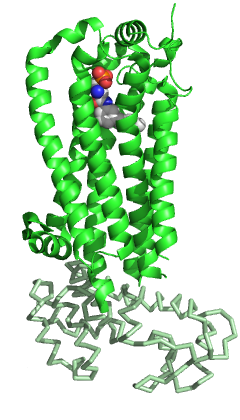Autotaxin, also known as ectonucleotide pyrophosphatase/phosphodiesterase family member 2 (E-NPP 2), is an enzyme that in humans is encoded by the ENPP2 gene. [5] [6]
Autotaxin, also known as ectonucleotide pyrophosphatase/phosphodiesterase family member 2 (E-NPP 2), is an enzyme that in humans is encoded by the ENPP2 gene. [5] [6]
Autotaxin is a secreted enzyme important for generating the lipid signaling molecule lysophosphatidic acid (LPA). Autotaxin has lysophospholipase D activity that converts lysophosphatidylcholine into LPA.
Autotaxin was originally identified as a tumor cell-motility-stimulating factor; later it was shown to be LPA (which signals through lysophospholipid receptors), the lipid product of the reaction catalyzed by autotaxin, which is responsible for its effects on cell-proliferation.
The protein encoded by this gene functions as a phosphodiesterase. Autotaxin is secreted and further processed to make the biologically active form. Several alternatively spliced transcript variants have been identified. Autotaxin is able to cleave the phosphodiester bond between the α and the β position of triphosphate nucleotides, acting as an ectonucleotide phosphodiesterase producing pyrophosphate, as most members of the ENPP family. Importantly, autotaxin also acts as phospholipase, catalyzing the removal of the head group of various lysolipids. The physiological function of autotaxin is the production of the signalling lipid lysophosphatidic acid (LPA) in extracellular fluids. LPA evokes growth factor-like responses including stimulation of cell proliferation and chemotaxis. This gene product stimulates the motility of tumor cells, has angiogenic properties, and its expression is up-regulated in several kinds of tumours. [6] Also, autotaxin and LPA are involved in numerous inflammatory-driven diseases such as asthma and arthritis. [7] Physiologically, LPA helps promote wound healing responses to tissue damage. Under normal circumstances, LPA negatively regulates autotaxin transcription, but in the context of wound repair, cytokines induce autotaxin expression to increase overall LPA concentrations. [8]
Various small molecule inhibitors of autotaxin have been developed for clinical applications. A specific inhibitor against idiopathic pulmonary fibrosis showed promising results in a phase II trial that ended in May 2018. [9] A DNA aptamer inhibitor of Autotaxin has also been described. [10]
Recently, it has been shown that THC is also a partial autotaxin inhibitor, with an apparent IC50 of 407 ± 67 nM for the ATX-gamma isoform. [11] THC was also co-crystallized with autotaxin, deciphering the binding interface of the complex. These results might explain some of the effects of THC on inflammation and neurological diseases, since autotaxin is responsible of LPA generation, a key lipid mediator involved in numerous diseases and physiological processes. However, clinical trials need to be performed in order to assess the importance of ATX inhibition by THC during medicinal cannabis consumption. Development of cannabinoid inspired autotaxin inhibitors could also be an option in the future.
The crystal structures of rat and mouse autotaxin [12] have been solved. In each case, the apo structure has been solved along with those of product- or inhibitor-bound complexes. Both proteins consist of 4 domains, including 2 N-terminal somatomedin-B-like (SMB) domains which may be involved in cell-surface localisation. The catalytic domain follows and contains a deep hydrophobic pocket in which the lipid substrate binds. At the C-terminus is the inactive nuclease domain which may function to aid protein stability.

A phosphodiesterase (PDE) is an enzyme that breaks a phosphodiester bond. Usually, phosphodiesterase refers to cyclic nucleotide phosphodiesterases, which have great clinical significance and are described below. However, there are many other families of phosphodiesterases, including phospholipases C and D, autotaxin, sphingomyelin phosphodiesterase, DNases, RNases, and restriction endonucleases, as well as numerous less-well-characterized small-molecule phosphodiesterases.
Phosphodiesterase 1, PDE1, EC 3.1.4.1, systematic name oligonucleotide 5′-nucleotidohydrolase) is a phosphodiesterase enzyme also known as calcium- and calmodulin-dependent phosphodiesterase. It is one of the 11 families of phosphodiesterase (PDE1-PDE11). Phosphodiesterase 1 has three subtypes, PDE1A, PDE1B and PDE1C which divide further into various isoforms. The various isoforms exhibit different affinities for cAMP and cGMP.

The PDE2 enzyme is one of 21 different phosphodiesterases (PDE) found in mammals. These different PDEs can be subdivided to 11 families. The different PDEs of the same family are functionally related despite the fact that their amino acid sequences show considerable divergence. The PDEs have different substrate specificities. Some are cAMP selective hydrolases, others are cGMP selective hydrolases and the rest can hydrolyse both cAMP and cGMP.

A lysophosphatidic acid (LPA) is a phospholipid derivative that can act as a signaling molecule.
The lysophospholipid receptor (LPL-R) group are members of the G protein-coupled receptor family of integral membrane proteins that are important for lipid signaling. In humans, there are eleven LPL receptors, each encoded by a separate gene. These LPL receptor genes are also sometimes referred to as "Edg".

Sphingosine-1-phosphate receptor 1, also known as endothelial differentiation gene 1 (EDG1) is a protein that in humans is encoded by the S1PR1 gene. S1PR1 is a G-protein-coupled receptor which binds the bioactive signaling molecule sphingosine 1-phosphate (S1P). S1PR1 belongs to a sphingosine-1-phosphate receptor subfamily comprising five members (S1PR1-5). S1PR1 was originally identified as an abundant transcript in endothelial cells and it has an important role in regulating endothelial cell cytoskeletal structure, migration, capillary-like network formation and vascular maturation. In addition, S1PR1 signaling is important in the regulation of lymphocyte maturation, migration and trafficking.

Lysophosphatidic acid receptor 1 also known as LPA1 is a protein that in humans is encoded by the LPAR1 gene. LPA1 is a G protein-coupled receptor that binds the lipid signaling molecule lysophosphatidic acid (LPA).

Lysophosphatidic acid receptor 4 also known as LPA4 is a protein that in humans is encoded by the LPAR4 gene. LPA4 is a G protein-coupled receptor that binds the lipid signaling molecule lysophosphatidic acid (LPA).

Lysophosphatidic acid receptor 2 also known as LPA2 is a protein that in humans is encoded by the LPAR2 gene. LPA2 is a G protein-coupled receptor that binds the lipid signaling molecule lysophosphatidic acid (LPA).

Lysophosphatidic acid receptor 6, also known as LPA6, P2RY5 and GPR87, is a protein that in humans is encoded by the LPAR6 gene. LPA6 is a G protein-coupled receptor that binds the lipid signaling molecule lysophosphatidic acid (LPA).

Lysophosphatidic acid receptor 5 also known as LPA5 is a protein that in humans is encoded by the LPAR5 gene. LPA5 is a G protein-coupled receptor that binds the lipid signaling molecule lysophosphatidic acid (LPA).

Lysophosphatidic acid receptor 3 also known as LPA3 is a protein that in humans is encoded by the LPAR3 gene. LPA3 is a G protein-coupled receptor that binds the lipid signaling molecule lysophosphatidic acid (LPA).

Ectonucleotide pyrophosphatase/phosphodiesterase family member 1 is an enzyme that in humans is encoded by the ENPP1 gene.

Lipid phosphate phosphohydrolase 3 (LPP3), also known as phospholipid phosphatase 3 (PLPP3) and phosphatidic acid phosphatase type 2B, is an enzyme that in humans is encoded by the PPAP2B gene on chromosome 1. It is ubiquitously expressed in many tissues and cell types. LPP3 is a cell-surface glycoprotein that hydrolyzes extracellular lysophosphatidic acid (LPA) and short-chain phosphatidic acid. Its function allows it to regulate vascular and embryonic development by inhibiting LPA signaling, which is associated with a wide range of human diseases, including cardiovascular disease and cancer, as well as developmental defects. The PPAP2B gene also contains one of 27 loci associated with increased risk of coronary artery disease.

The human gene AGK encodes the enzyme mitochondrial acylglycerol kinase.

Lipase member H is an enzyme that in humans is encoded by the LIPH gene.

Neutral cholesterol ester hydrolase 1 (NCEH) also known as arylacetamide deacetylase-like 1 (AADACL1) or KIAA1363 is an enzyme that in humans is encoded by the NCEH1 gene.

Gintonin is a glycolipoprotein fraction isolated from Panax ginseng. The non-saponin ingredient was designated as gintonin, where gin was derived from ginseng, ton from the tonic effects of ginseng, and in from protein. The main component of gintonin is a complex of lysophosphatidic acids (LPA) and ginseng proteins such as ginseng major latex-like protein151 (GLP151) and ginseng ribonuclease-like storage protein.

Nucleotide pyrophosphatase/phosphodiesterase (NPP) is a class of dimeric enzymes that catalyze the hydrolysis of phosphate diester bonds. NPP belongs to the alkaline phosphatase (AP) superfamily of enzymes. Humans express seven known NPP isoforms, some of which prefer nucleotide substrates, some of which prefer phospholipid substrates, and others of which prefer substrates that have not yet been determined. In eukaryotes, most NPPs are located in the cell membrane and hydrolyze extracellular phosphate diesters to affect a wide variety of biological processes. Bacterial NPP is thought to localize to the periplasm.

Lysophosphatidic acid phosphatase type 6 is an acid phosphatase enzyme that is encoded in humans by the ACP6 gene.